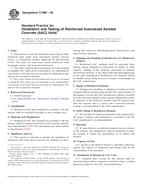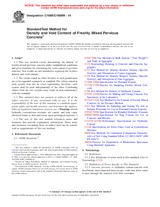Potřebujeme váš souhlas k využití jednotlivých dat, aby se vám mimo jiné mohly ukazovat informace týkající se vašich zájmů. Souhlas udělíte kliknutím na tlačítko „OK“.
ASTM C803/C803M-03(2010)
Standard Test Method for Penetration Resistance of Hardened Concrete
Automaticky přeložený název:
Standardní zkušební metoda pro penetrační odpor ztvrdlého betonu
NORMA vydána dne 1.6.2010
Informace o normě:
Označení normy: ASTM C803/C803M-03(2010)
Poznámka: NEPLATNÁ
Datum vydání normy: 1.6.2010
Kód zboží: NS-15127
Počet stran: 5
Přibližná hmotnost: 15 g (0.03 liber)
Země: Americká technická norma
Kategorie: Technické normy ASTM
Kategorie - podobné normy:
Anotace textu normy ASTM C803/C803M-03(2010) :
Keywords:
concrete strength, concrete uniformity, in-place strength, in-place test, penetration resistance, Hardened concrete, Nondestructive evaluation (NDE)--concrete/masonry, Penetration--cement/concrete, Probe methods, Steel probe, Strength--cement/concrete mixtures/applications, Uniformity of concrete, Windsor probe method, ICS Number Code 91.100.30 (Concrete and concrete products)
Doplňující informace
| Significance and Use | ||||||
|
This test method is applicable to assess the uniformity of concrete and to delineate zones of poor quality or deteriorated concrete in structures. This test method is applicable to estimate in-place strength, provided that a relationship has been experimentally established between penetration resistance and concrete strength. Such a relationship must be established for a given test apparatus (see also 9.1.5), using similar concrete materials and mixture proportions as in the structure. Use the procedures and statistical methods in ACI 228.1R for developing and using the strength relationship. Note 1— Since penetration results may be affected by the nature of the formed surfaces (for example, wooden forms versus steel forms), correlation testing should be performed on specimens with formed surfaces similar to those to be used during construction. Additional information on the factors affecting penetration test results and summaries of past research are available. , Steel probes are driven with a high-energy, powder-actuated driver, and probes may penetrate some aggregate particles. Probe penetration resistance is affected by concrete strength as well as the nature of the coarse aggregate. Steel pins are smaller in size than probes and are driven by a low energy, spring-actuated driver. Pins are intended to penetrate the mortar fraction only; therefore, a test in which a pin strikes a coarse aggregate particle is disregarded. This test method results in surface damage to the concrete, which may require repair in exposed architectural finishes. |
||||||
| 1. Scope | ||||||
|
1.1 This test method covers the determination of the resistance of hardened concrete to penetration by either a steel probe or pin. 1.2 The values stated in either SI units or inch-pound units are to be regarded separately as standard. The values stated in each system may not be exact equivalents; therefore, each system shall be used independently of the other. Combining values from the two systems may result in nonconformance with the standard. 1.3 This standard does not purport to address all of the safety concerns, if any, associated with its use. It is the responsibility of the user of this standard to establish appropriate safety and health practices and determine the applicability of regulatory limitations prior to use. For specific hazard statements, see Section 7. |
||||||
| 2. Referenced Documents | ||||||
|
Podobné normy:
Historická
15.12.2008
Historická
1.9.2011
Historická
1.10.2009
Historická
1.7.2014
Historická
1.12.2011
Historická
1.12.2011
Doporučujeme:
Aktualizace zákonů
Chcete mít jistotu o platnosti užívaných předpisů?
Nabízíme Vám řešení, abyste mohli používat stále platné (aktuální) legislativní předpisy.
Chcete vědět více informací? Podívejte se na tuto stránku.



 ASTM C1646/C1646M-08..
ASTM C1646/C1646M-08.. ASTM C1677-11a
ASTM C1677-11a ASTM C1686-09
ASTM C1686-09 ASTM C1688/C1688M-14..
ASTM C1688/C1688M-14.. ASTM C1691-11
ASTM C1691-11 ASTM C1692-11
ASTM C1692-11
 Cookies
Cookies
